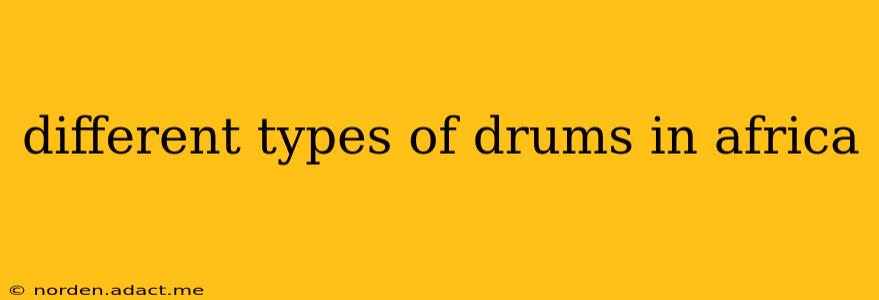Africa's rich musical heritage is deeply intertwined with its diverse drumming traditions. From the vibrant soundscapes of West Africa to the intricate rhythms of Southern Africa, drums serve as vital instruments for communication, storytelling, and celebration. This exploration delves into the fascinating world of African drums, highlighting the variety in construction, sound, and cultural significance. Understanding the different types of drums found across the continent requires acknowledging the sheer breadth of its cultural landscape – each region boasting its own unique drumming traditions and instruments.
What are the main types of African drums?
This question is difficult to answer definitively because the sheer variety of drums across Africa makes broad categorization challenging. However, we can group them based on construction and playing techniques. Common categories include:
- Single-headed drums: These drums have a single drumhead stretched over a shell. They are often played with sticks or hands, producing a wide range of tones and pitches.
- Double-headed drums: As the name suggests, these possess two drumheads. The tension of the heads can be adjusted to alter the pitch, creating a wider range of sounds compared to single-headed drums.
- Pot drums: These drums feature a clay or ceramic shell, often cylindrical or bowl-shaped. Their sounds are characteristically resonant and earthy.
- Frame drums: These drums consist of a membrane stretched over a circular frame. They are often played with the hands or sticks and are commonly found in North Africa.
It's crucial to remember that this is a simplified classification, and many drums defy neat categorization.
What are some examples of specific African drums?
Let's explore some specific examples, highlighting their regional origins and unique characteristics:
-
Djembe (West Africa): Perhaps the most internationally recognized African drum, the djembe is a goblet-shaped drum played with bare hands. Its versatile sound allows it to produce a wide range of tones, from deep bass to high-pitched slaps. Its popularity extends beyond West Africa, making it a staple in many global musical genres.
-
Talking Drum (West Africa): This iconic drum is known for its ability to mimic human speech. By skillfully manipulating the ropes that tighten its membrane, musicians can modulate the pitch, creating an almost conversational sound. Used for communication and storytelling, it holds immense cultural significance.
-
Conga (Cuba, influenced by Afro-Cuban traditions): Although not strictly of purely African origin, the conga drum's lineage traces back to African drumming traditions that arrived in Cuba via the transatlantic slave trade. The conga's distinctive sound has made it a global percussion staple.
-
Ngoni (East and Southern Africa): A family of stringed instruments, the ngoni encompasses various forms including the ngoni, litimba, and kiyimbi. Often built from wood, gourds, and animal skins, it is played by plucking or strumming strings.
-
Kora (West Africa): Another stringed instrument, the kora holds a significant place in West African music. This harp-like instrument usually has 21 strings and creates beautiful melodic sounds with a range of tonal qualities.
This is just a small sampling. Numerous other drums exist, each with its unique sounds and cultural context.
How are African drums made?
The construction of African drums is a highly skilled craft, often passed down through generations. The materials used vary greatly depending on the region and the specific drum. Common materials include:
- Wood: Various types of wood are used for the drum shell, chosen for their resonance and durability.
- Animal hides: Goat, cow, or antelope skin is commonly used for the drumhead. The preparation of the hide is a critical process, affecting the drum's sound and longevity.
- Metal: Some drums incorporate metal components, such as rings or hoops, to reinforce the shell or drumhead.
- Clay/Ceramic: Pot drums utilize clay or ceramic for their shell, offering unique tonal characteristics.
- Gourds: Gourds serve as a natural shell for many drums, creating a distinctive and often resonant sound.
What is the significance of African drums in their respective cultures?
African drums are far more than just musical instruments; they are integral to the cultural fabric of many African societies. Their roles include:
- Communication: In some cultures, drums are used for long-distance communication, sending messages across vast distances.
- Storytelling: Rhythmic patterns and drumming techniques can convey narratives, passing down traditions and history through generations.
- Rituals and ceremonies: Drums play a vital role in religious and ceremonial practices, often used to invoke spirits or celebrate important events.
- Social cohesion: Drumming often brings communities together, fostering a sense of unity and shared identity.
- Entertainment and celebration: Drums are central to musical performances and celebrations, adding vibrancy and energy to social gatherings.
This exploration merely scratches the surface of the vast and diverse world of African drums. Each drum type holds a unique place within its respective culture, reflecting the continent's rich artistic heritage and the ingenuity of its people. Further research into specific regions and drum types will reveal even deeper layers of meaning and significance.
